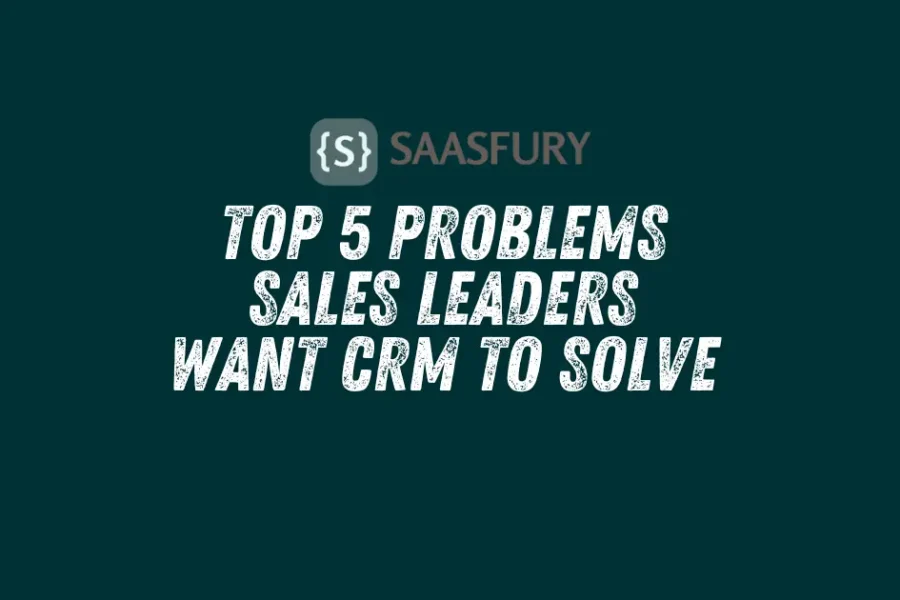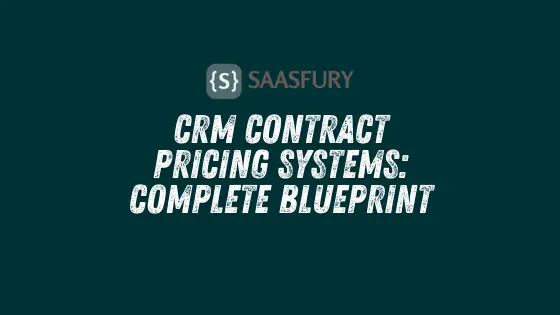Many CRM programs fail due to poor user adoption and a lack of clear business goals. Without these, CRMs can’t deliver results.
Implementing a CRM system can revolutionize a business by streamlining customer interactions and improving sales processes. Yet, many companies struggle with CRM adoption, leading to unsuccessful outcomes. Key reasons include inadequate training, unclear objectives, and resistance to change from staff.
Employees often find new systems cumbersome, which hampers effective usage. Additionally, without a clear strategy, businesses fail to leverage CRM capabilities fully. It’s crucial to involve all stakeholders, provide comprehensive training, and set measurable goals. Effective communication and continuous support can enhance CRM adoption, ensuring long-term success. Proper planning and commitment can transform a CRM from a mere tool into a powerful asset.
Table of Contents
Customer Relationship Management (CRM) programs are essential tools for businesses. They help manage customer data, interactions, and relationships. Despite their importance, many CRM programs fail. They understand why can help businesses make better decisions.
What Is CRM?
CRM stands for Customer Relationship Management. It is a strategy or software used to manage a company’s interactions with customers. A CRM system stores customer data, tracks interactions, and helps in sales and customer service.

CRM systems can include various features like contact management, sales management, and productivity tools. They aim to improve business relationships, streamline processes, and increase profitability.
Importance In Business
CRM programs play a crucial role in business success. Here are some key reasons:
- Improved Customer Relationships: CRM systems help businesses understand their customers better.
- Increased Sales: By tracking customer interactions, sales teams can identify opportunities.
- Better Customer Service: CRM systems store customer history, making support more efficient.
- Enhanced Productivity: Automation and integration features save time and reduce errors.
Despite these benefits, many CRM programs fail to deliver. Businesses must understand the reasons behind these failures to achieve success.
Common Pitfalls
Many CRM programs fail due to several common pitfalls. These issues can be addressed if identified early. Let’s explore some of these pitfalls.
Lack Of Clear Objectives
Many businesses start using CRM without clear objectives. They don’t define what they want to achieve. This leads to confusion and wasted resources.
Businesses should set specific goals for their CRM. These goals might include:
- Improving customer service
- Increasing sales
- Enhancing customer retention
Having clear objectives helps the team stay focused. It also ensures the CRM system delivers value.
Inadequate User Training
Another common pitfall is inadequate user training. Employees must know how to use the CRM system effectively. Without proper training, they might resist using it.
Providing comprehensive training sessions can solve this issue. Training should cover:
- Basic functionalities
- Advanced features
- Best practices
Investing in user training boosts adoption and usage. Well-trained employees can maximize the benefits of the CRM system.
Technology Challenges
Many CRM programs fail due to various technology challenges. These challenges can disrupt the smooth implementation and operation of CRM systems. Two major issues that often arise are integration issues and data migration problems.
Integration Issues
Integration issues occur when CRM systems don’t seamlessly connect with other software. This can cause data silos, where information is trapped in one system and not shared across others. Let’s explore some common integration challenges:
- Compatibility: Older software may not work well with new CRM systems.
- APIs: Inconsistent or poorly designed APIs hinder smooth data flow.
- Real-time Updates: Delays in data updates can cause inefficiencies.
Overcoming these issues requires careful planning and robust technical support. Companies must ensure their CRM can integrate with existing systems.
Data Migration Problems
Data migration involves transferring data from old systems to the new CRM. This process is crucial yet challenging. Here are some typical problems faced during data migration:
| Problem | Description |
|---|---|
| Data Loss | Important data can be lost during transfer. |
| Data Corruption | Data can become corrupted if not handled properly. |
| Inconsistent Formats | Data formats may differ between old and new systems. |
To avoid these problems, companies should:
- Conduct thorough data audits before migration.
- Use reliable data migration tools.
- Test data integrity post-migration.
Successful data migration ensures that the new CRM system has accurate and complete information.
User Adoption
User adoption is a crucial factor for CRM success. Without it, even the best CRM systems can fail. Understanding why users resist adoption helps businesses address these issues effectively.
Resistance To Change
Many employees resist change. They prefer familiar tools and processes. New CRM systems often disrupt their daily routines. This disruption can cause frustration and reluctance.
Communication is key to overcoming this. Training sessions and open forums help ease the transition. Employees feel more comfortable when they understand the benefits.
- Provide thorough training
- Offer continuous support
- Highlight the benefits
Usability Concerns
Some CRM systems are complicated. Complex interfaces and features can intimidate users. If a CRM is hard to use, employees may avoid it.
Simplicity is important. A user-friendly interface encourages adoption. Provide clear instructions and easy navigation to enhance usability.
| Usability Feature | Benefit |
|---|---|
| Simple Interface | Reduces confusion |
| Clear Instructions | Guides users easily |
| Easy Navigation | Speeds up tasks |
Testing the CRM with a small group first can help. Gather feedback and make necessary adjustments. This ensures the system meets user needs.
Management Commitment
Management commitment plays a critical role in the success of CRM programs. Without strong support from leadership, many CRM initiatives fail to meet their goals. This section will explore why management commitment is essential and how it impacts CRM success.
Leadership Support
Leadership support is vital for any CRM program. Leaders set the tone for the entire organization. Their active involvement signals the importance of the CRM initiative. Employees are more likely to engage when they see top management’s commitment.
Effective leaders communicate the CRM vision clearly. They make sure everyone understands the benefits and goals. This fosters a sense of purpose and direction among team members. Leaders also provide the necessary motivation to keep the project on track.
Resource Allocation
A successful CRM program requires adequate resources. These include time, money, and skilled personnel. Management must ensure that these resources are available. Without proper allocation, the CRM initiative may falter.
Resource allocation involves careful planning. Management must identify what is needed and when. This may include hiring experts, investing in technology, and providing training. Proper allocation helps in smooth implementation and reduces the risk of failure.
Below is a table highlighting the key resources required for a successful CRM program:
| Resource | Importance |
|---|---|
| Time | Allows thorough planning and execution |
| Money | Funds technology and training |
| Skilled Personnel | Ensures expertise and efficiency |
In summary, both leadership support and resource allocation are crucial. Management commitment ensures the CRM program has the necessary backing to succeed. This fosters a culture of engagement and dedication among employees.
Customization Mistakes
Customization can enhance CRM programs. But mistakes often lead to failures. Understanding common mistakes helps prevent them. Let’s explore two major pitfalls.
Over-complex Solutions
Some businesses overcomplicate their CRM systems. They add too many features. This makes the system hard to use.
Employees struggle with complex interfaces. They waste time learning unnecessary tools. This decreases productivity.
Consider a CRM system with too many options. Employees feel overwhelmed. They often revert to manual processes. This defeats the purpose of the CRM.
Keep your CRM simple. Focus on essential features. A streamlined system is easier to manage.
Underestimating Needs
Many businesses underestimate their CRM needs. They choose basic solutions. These systems lack the necessary functionalities.
For example, a growing company may need advanced reporting. A basic CRM might not offer this. The company then struggles to make data-driven decisions.
Assess your business needs thoroughly. Choose a CRM that meets those needs. Avoid outgrowing your CRM too quickly.
Consider scalability. A scalable CRM grows with your business. It supports future needs without major overhauls.
| Common Mistake | Impact |
|---|---|
| Over-Complex Solutions | Decreased productivity and usability |
| Underestimating Needs | Lack of essential functionalities |
In summary, avoid over-complex solutions. Don’t underestimate your needs. Choose a CRM that fits your business. Ensure it supports growth.
Data Quality
Data quality is a critical aspect of any CRM program. Poor data quality can lead to ineffective customer relationship management. It affects decision-making, customer satisfaction, and overall business performance.
Inaccurate Data
One major issue with CRM programs is inaccurate data. Inaccurate data can come from various sources:
- Manual data entry errors
- Outdated information
- Incomplete records
Manual data entry often leads to typos and mistakes. Outdated information makes your CRM less reliable. Incomplete records provide an unclear picture of the customer.
Companies need to ensure data accuracy. Regular audits and automated data validation tools can help. Accurate data leads to better decision-making and customer interactions.
Data Silos
Data silos are another common problem. Data silos occur when data is isolated in separate systems:
| System | Data Type |
|---|---|
| Sales | Customer orders |
| Marketing | Lead information |
| Support | Service tickets |
Data silos make it hard to get a complete view of the customer. Each department has its own data, which may not be shared. Integrating systems can break down data silos. This provides a unified view of customer interactions.
Effective CRM relies on high-quality data. Addressing issues like inaccurate data and data silos is crucial. Ensure your CRM program succeeds by maintaining data quality.
Measuring Success
Understanding why many CRM programs fail often boils down to one key factor: measuring success. Without clear metrics, it’s hard to gauge the effectiveness of any CRM system. Defining what success looks like is crucial. This involves setting up specific, measurable goals and tracking progress consistently.
Key Performance Indicators
To measure success, identify and track Key Performance Indicators (KPIs). These indicators help you understand whether your CRM is achieving its goals. Some common KPIs include:
- Customer Retention Rate
- Sales Growth
- Customer Satisfaction Score (CSAT)
- Lead Conversion Rate
Customer Retention Rate measures the percentage of customers who stay with your company. A higher retention rate indicates a successful CRM. Sales Growth tracks revenue increases over time. Customer Satisfaction Score (CSAT) gauges how happy your customers are. Lead Conversion Rate shows the percentage of leads that become paying customers. Monitoring these KPIs helps you understand your CRM’s impact.
Continuous Improvement
For a CRM to succeed, it needs continuous improvement. Regularly review your KPIs to identify areas for enhancement. Use this data to make informed decisions. Implement changes to improve performance and meet your goals.
Create a feedback loop. Gather input from your team and customers. Use this feedback to refine your CRM processes. An agile approach ensures your CRM adapts to new challenges and opportunities.
Set up regular training sessions for your team. Ensure they are well-versed in CRM functionalities. This helps in maximizing the potential of your CRM system. Keep your team updated with new features and best practices.
By focusing on continuous improvement, you can make sure your CRM evolves with your business needs. This proactive approach minimizes the chances of failure.
Best Practices
Many CRM programs fail due to a lack of proper execution. Adopting best practices can significantly improve the success rate of CRM implementations. Here, we will explore two key practices: setting clear goals and providing effective training.
Clear Goals
Setting clear goals is crucial for the success of a CRM program. Without defined objectives, it’s easy to lose direction. Goals should be specific, measurable, attainable, relevant, and time-bound (SMART).
- Specific: Clearly outline what you aim to achieve.
- Measurable: Ensure you can track your progress.
- Attainable: Set realistic and achievable goals.
- Relevant: Align goals with your business needs.
- Time-bound: Set deadlines to keep on track.
For example, instead of saying “improve customer service,” specify “reduce response time to customer queries by 20% within six months.”
Effective Training
Effective training is vital for a successful CRM program. Employees must know how to use the CRM system efficiently. Poor training leads to underutilization and errors.
- Initial Training: Introduce the CRM system and its features.
- Ongoing Training: Provide regular updates and refresher courses.
- Role-Specific Training: Tailor training to different user roles.
Use various training methods like workshops, online tutorials, and hands-on sessions. Provide support materials such as manuals and FAQs.
Training should be an ongoing process. Regularly update training materials to reflect software updates.
Conclusion
Many CRM programs fail due to poor implementation, lack of user training, and inadequate customization. To succeed, businesses must plan thoroughly, invest in training, and tailor the CRM to their needs. By addressing these challenges, companies can improve their CRM effectiveness and drive better business outcomes.







Leave a Comment